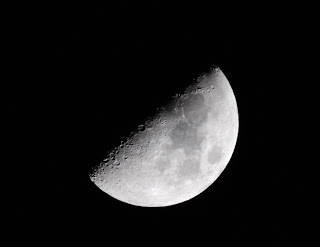Moon near Half-phase
Leo Triplet Galaxies M65, M66 and NGC3628
M3 Globular Star Cluster
M13 Globular Star Cluster
M37 Star Cluster
M51 Whirlpool Galaxy
M81 and M82 Galaxies
I attended my first Norther Virginia Astronomy Club (NOVAC) event on Saturday, April 12th. It was a public viewing event at Crocket Park in Fauquier County, Va . At these events, astronomy club members set up telescopes for the public to view celestial objects . It is a good way to get more people involved in astronomy.
When I arrived at 8PM the temperature was 75F with no wind. By 10:30PM the wind became gusty (15-20MPH with higher gusts) and the temperature dropped to 48F. Glad I brought my 'Hoodie', because I needed it.
I had a chance to give public viewers a tour of the night sky by guiding my telescope at: Saturn, The Great Orion Nebula (M42), Galaxies M81 & M82 (in Ursa Major), Globular Star Clusters ( M3 and M13) and Open Star Cluster M36, M37, M38 and M45 (The Pleiades).
By 11PM most public viewers departed, so I took the opportunity to do some astrophotography. Viewing and photography conditions were not the best, but this being the first cloudless night in weeks, I was not going to complain.
The posted pictures are not the best quality, because the wind was blowing my telescope around, and moisture in the upper atmosphere reflected a lot of light from an exceptionally bright Half-Moon.
Quote of the Day: Astronomy's much more fun when you're not an astronomer!
StarPilot
.
Monday, April 14, 2008
"Night Under the Stars" (April 12th, 2008)
Friday, April 4, 2008
Observation Log for April 2nd, 2008
Finally! After a month of cloudy nights, I was able to take my telescope outside and view some celestial objects. The temperature was near 40F, there was no wind and seeing conditions were fair. The night was also moonless. My only problem was light pollution. Four of my neighbors decided to turn on their proch lights, and one in particular chimed in by running two ground-level flood lamps. Gee! Thanks Mike!
Because of the light pollution, I was unable to take any pictures due to light glare glossing over everything in my camera's viewfinder.
I am not allowed to use a shroud (a mini-tent that covers my head) to block ambient light, because I do my viewing in the front yard and my 'young bride of 31 years' said NO! Something about being viewed by the neighbors as being wierd. :(
In Lieu of pictures, I have added links to Wikipedia articles for each celestial object I viewed. Please bear in mind that the Wiki pictures are from Hubble and other multi-million dollar telescopes. My view of each object was much less detailed.
- - M36, M37, and M38 (Star Clusters) in the constellation Auriga
- Observation: M36 & M38 appeared as richly dense star fields with thousands of visible points of light. M37 was an impressive open cluster. This is my first sighting of these Messier objects.
http://en.wikipedia.org/wiki/Messier_36
http://en.wikipedia.org/wiki/Messier_37
http://en.wikipedia.org/wiki/Messier_38
- - M42 (Orion Nebula) in the constallation Orion
- Observation: The view of M42 was great through my 5mm, 13mm and 24mm eyepieces. The stars in the 'Trapezium' were razor sharp.
- - M51 (Whirlpool Galaxy) in the constellation Ursa Major (Big Dipper)
- Observation: The galaxy was faint and I did not see the cloud aligned near the tail due to light pollution and some haze near the horizon, where this object sits. This is my first sighting of M51.
- - M66, M67 and NGC3628 (Galaxies) in the constellation Leo (called the Leo Triplet)
- Observation: I was able to see all three galaxies, though NGC3628 was more like a smudge because of local light pollution. This is my first sighting of these Messier objects.
http://en.wikipedia.org/wiki/Messier_66
http://en.wikipedia.org/wiki/NGC_3628
- - M81 and M82 (Galaxies) in the constellation Ursa Major
- Observation: I was able to make both these Messier objects out in descent detail using an 8mm eyepiece, and better detail using 13mm and 24mm eyepieces. Very impressive.
http://en.wikipedia.org/wiki/Messier_82
- - Saturn near the star "Regulus" in the constellation Leo
- Observation: Using the Baader 5mm eyepiece I was able to make out faint hints of the Cassini divide in the rings and some surface details. This has been my best view of Saturn to date.
I was offered to take my telescope to a co-workers home in a more rural area. I think I may take him up on that offer when the weather warms a little more.
Clear Skies!
StarPilot
Posted by
Star Geezer
at
12:27 PM
1 comments
![]()
![]()
Labels: auriga, Leo triplets, M36, m37, m38, m42, m51, m65, M66, m81, m82, open cluster, Orion, star cluster






